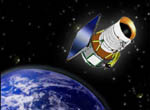WISE

Widefield Infrared Survey Explorer
Phase: Past
Launch Date: December 14, 2009
Mission Project Home Page - http://wise.ssl.berkeley.edu/
Program(s):Astrophysics Explorers, Explorers
Astronomers used images from NASA's WISE to locate an aging star shedding loads of dust (orange dot at upper left).
Image credit: NASA/JPL-Caltech
Launched in December of 2009, the WISE spacecraft spent over a year imaging the entire sky. WISE orbited the Earth several hundred miles above the dividing line between night and day on Earth, carrying an infrared-sensitive telescope that was kept very cold (below -430º F / 15º K) by a cryostat which is like an ice chest but filled with solid hydrogen instead of ice.
Looking at right angles to the Sun, the infrared-sensitive telescope pointed away from Earth allowing WISE to observe the whole sky in just six months. Capturing an image every 11 seconds, each picture covered an area of the sky 3 times larger than the full moon. Each picture had one megapixel resolution at each of four wavelengths that ranged from 5 to 35 times longer than the longest waves that the human eye can see. The data taken by WISE was downloaded by radio transmission four times per day and combined into an atlas covering the entire celestial sphere.
Besides surveying the infrared sky, WISE also had a second purpose. The NEOWISE Survey used the infrared telescope to survey the small bodies, asteroids, and comets in our solar system.
After completing its primary mission to map the infrared sky, WISE reached the expected end of its onboard supply of frozen hydrogen coolant in October of 2010. Two of the four infrared detectors were still viable at the warmer temperatures, allowing WISE to spend several more months completing the NEOWISE Post-Cryogenic mission, scanning for near-Earth objects. WISE was decommissioned in February of 2011.
During the course of the mission, WISE took millions of infrared images. It discovered 20 new comets, more than 33,000 asteroids in the main belt between Mars and Jupiter, and 134 near-Earth objects (NEOs). NEOs are asteroids and comets with orbits that come within 45 million kilometers (28 million miles) of Earth’s path around the Sun.
The science team is now analyzing millions of objects captured in the WISE images. The first batch of WISE data, covering slightly more than half the sky, was released to the astronomical community in spring 2011, with the rest to follow one year later.
During its one-year mission WISE mapped the entire sky in infrared light. Among the multitudes of astronomical bodies that have been discovered by the NEOWISE portion of the WISE mission are 20 comets. The colors in the pictures are representational. Infrared light of 4.6, 12 and 22 microns is colored blue, green and red, respectively. The light emitted from comets in infrared is due to their temperatures, so the cooler objects appear to have more red, while warmer objects will appear more bluish.
Image Credit:NASA/JPL-Caltech/UCLA
Last Updated: June 7, 2012
- More about WISE - http://www.nasa.gov/mission_pages/WISE/main/index.html


